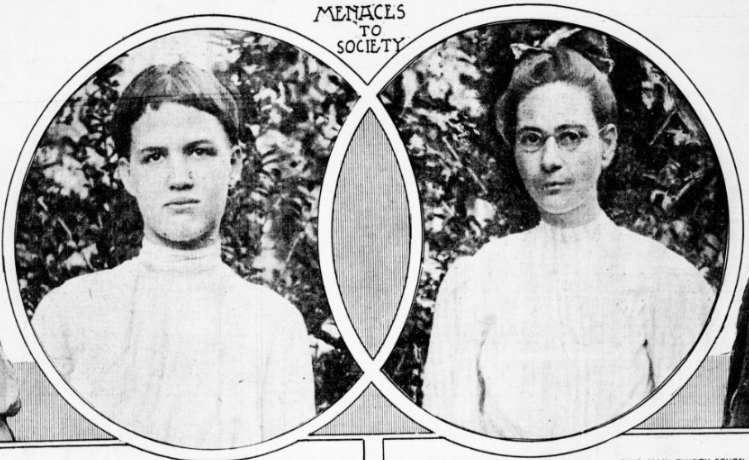The Dehumanizing Effects of Eugenics: Disability History Lesson Plan
By Rich Cairn
The engravings on the right of two young women are haunting. Aside from the clothing, these faces could easily be high school or college students today. Yet these images appeared in the New York Tribune in 1912 under the headline, “Eugenists Would Improve Human Stock by Blotting Out Blood Taints,” with the subheading, “Menaces to Society.” These women represent the millions of targets of eugenics.
We must do a better job of explaining these stories and the history of American eugenics to better reflect the agency of people with disabilities. And we must examine disability and eugenics both as an important spur to genocide and as targets of genocide.
Eugenics and Agency in Disability History
When we created the K-12 Disability History Curriculum: Reform to Equal Rights, our primary goal was to empower all learners. The curriculum traces the arc of disability history from the early 19th century to today. When we studied existing curricula on the American eugenics movement, we found that most of them repeated an approach: explain eugenics thinking, share how it was spread including the names of many prominent supporters, share its impacts on tens of thousands of victims, and explain that it disappeared due to its association with Nazism and the Holocaust. Yet such an approach runs the real risk of validating the very ideology that it truly aims to counteract.
So when we created The Dehumanizing Effects of Eugenics, the lesson began with critiques from the time, including most notably, lawyer Clarence Darrow, and with a close analysis of bogus science at the movement’s core. We do include some explanation of how it worked, who supported it, how many Americans it hurt, and its influence on the Nazis and other supremacists. Yet the lesson quickly pivots to landmark efforts in North Carolina and other states to acknowledge and atone for the harms of eugenics carried on right into the 1980s and beyond. To understand how America came to abhor and condemn eugenics, students examine the discussion in North Carolina when it passed legislation in 2012 not only to admit wrong but to set up a system of cash payments in restitution to victims of the state’s forced sterilization program.
The Dehumanizing Effects of Eugenics lesson plan is part of a unit on the Progressive Era.
Eugenics and Disability as Genocide Education
Formal definitions of genocide, such as in 2022 Massachusetts legislation (below), typically fail to include disability. Yet this denies history and the experiences of millions of disabled Americans.
Eugenics is a core part of the history of people with disabilities. The goal of eugenicists was to exterminate people with disabilities as a class. This included isolating them by the hundreds of thousands–including by gender–in “asylums,” “hospitals,” “schools,” and camps, in part explicitly so they could not have children. Going further, many states involuntarily sterilized at least 60,000. Tools of control also included substandard diet, physical restraints, extensive use of sedatives and narcotics, beatings, lobotomy and electroshock to the brain.
Eugenics is essential to understanding genocide in the 20th and 21st centuries. From the early 19th century, perceived physical or mental weakness provided a central justification for the subjugation of Blacks, Native Americans, women, immigrants, and of course, people with disabilities. These ideas carried over into eugenicist and related nationalist ideologies of the late 19th and early 20th centuries. Ideas, laws and processes of eugenics in America were enthusiastically adapted and greatly extended by the Nazis, including the T-4 program of clinical murder of people with disabilities. Systemic murder of Jews, Roma and Slavs were also founded in part on the idea of eliminating groups that the fascists viewed as physically and mentally “defective.” That being one of the many terms of the early 20th century that we replace with the more acceptable term, “disabled.”
Eugenics and Action Looking Forward
On the one hand, Reform to Equal Rights’s lesson on eugenics as disability history offers a means to deeper understanding of the roots and the structures of the Holocaust and other genocides. More importantly, the independent living movement and the other disability rights movements of the late 20th century (explored in subsequent lessons of Reform to Equal Rights) present a range of creative and effective models of empowerment and civic action. Given the resurgence of eugenics ideas today–in shape and in practice if not in name–these lessons may prove to be invaluable.
References
- Euthanasia Program and Aktion T4. United States Holocaust Memorial Museum.
- Eugenists Would Improve Human Stock by Blotting Out Blood Taints. New-York Tribune. February 18, 1912, Page 2, Image 16. Chronicling America, Library of Congress.
- Stop Forced Sterilization. Rachael Romero. San Francisco Poster Brigade. (1977). Library of Congress.
- Douglas Bayton, Disability and the Justification of Inequality in American History. (2001). Disability History Museum.
- Ruth Hubbard & Stuart Newman. Yuppie Eugenics: Creating a world with genetic haves and have-nots. (2018). In Beyond Bioethics.
- Robert A. Wilson. Eugenics never went away. (2018). Aeon.
- Massachusetts Legislature. The 2021 Massachusetts law S. 2557 defines genocide as follows:
- “Genocide”, at least 1 of the following acts committed with the intent to destroy, in whole or in part, a national, ethnic, racial or religious group: (i) killing members of a national, ethnic, racial or religious group; (ii) causing serious bodily or mental harm to members of a national, ethnic, racial or religious group; (iii) deliberately inflicting conditions of life of a national, ethnic, racial or religious group in a manner calculated to bring about the physical destruction of the group, in whole or in part; (iv) imposing measures intended to prevent births within a national, ethnic, racial or religious group; or (v) forcibly transferring children of a national, ethnic, racial or religious group to another national, ethnic, racial or religious group.”
- “Genocide”, at least 1 of the following acts committed with the intent to destroy, in whole or in part, a national, ethnic, racial or religious group: (i) killing members of a national, ethnic, racial or religious group; (ii) causing serious bodily or mental harm to members of a national, ethnic, racial or religious group; (iii) deliberately inflicting conditions of life of a national, ethnic, racial or religious group in a manner calculated to bring about the physical destruction of the group, in whole or in part; (iv) imposing measures intended to prevent births within a national, ethnic, racial or religious group; or (v) forcibly transferring children of a national, ethnic, racial or religious group to another national, ethnic, racial or religious group.”
Further Resources
Browse the updated Resources for Teaching about Genocide Emerging America blog post from 2022.
Explore the Reform to Equal Rights: K-12 Disability History Curriculum, published by Emerging America with support from the Library of Congress Teaching with Primary Sources program.
Choices Program: Disability Histories Now - including resources on disability justice.
Facing History and Ourselves - Thoroughly resourced lessons documenting the impacts of eugenics in the U.S. and of the Nazi persecution and systematic murder of people with disabilities.
Chapter 19: The Progressive Era: Eugenics - Teaching American History - includes documents showing opposition to eugenics.
Rich Cairn, social studies inclusion specialist for Emerging America, authored the groundbreaking Reform to Equal Rights: K-12 Disability History Curriculum, funded by the Library of Congress Teaching with Primary Sources program. He serves on the board of the Disability History Museum and as Director of Programs for the Disability History Association. Learn more about Rich and the Emerging America Team.








